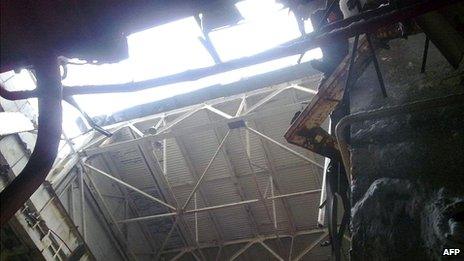Ukraine: Chernobyl nuclear roof collapse 'no danger'
- Published

A section of the roof at Ukraine's Chernobyl nuclear plant has collapsed - but there has been no increase in radiation at the site, authorities say.
No-one was hurt when the roof over a turbine hall gave way under heavy snow.
The "sarcophagus" used to seal off the failed reactor was unaffected, officials said, but around 80 construction workers were moved away.
The 1986 explosion and reactor meltdown at Chernobyl was the world's worst-ever nuclear accident.
Correspondents say the roof collapse will revive concerns about the condition of the defunct power plant.
"There are no changes in the radiation situation at the Chernobyl nuclear power plant or in the exclusion zone," Chernobyl's administrators said in a statement.
'Stay calm'
The affected area was about 50m (165 feet) away from the sarcophagus built to contain leaking radiation from the exploded reactor, Chernobyl spokeswoman Maya Rudenko told the Associated Press.
"Everyone should stay calm," Ms Rudenko said. "Yes it is unpleasant, but there is no danger."
A huge new containment structure is currently being built to slide over the reactor, amid concerns about the long-term viability of the existing encasement.
The concrete shell is being built by French construction companies and funded by the European Bank for Reconstruction and Development, as well as other donors. After the roof collapse, two firms, Vinci and Bouygues, moved their workers away from the site as a precaution.
The explosion at Chernobyl's number four reactor in 1986 - when Ukraine was still part of the Soviet Union - sent a huge plume of radiation across Europe.
Hundreds of thousands of people were evacuated from their homes in Ukraine, western Russia and Belarus.
The number of people who died because of the accident remains controversial, but thousands are thought to be at higher risk of cancer as a result of exposure to radiation.
The area around the plant is heavily contaminated and a 30km (19 mile) exclusion zone is in force.
- Published26 April 2011
- Published12 September 2011
- Published21 July 2011
- Published23 March 2011
- Published18 March 2011
- Published19 April 2011